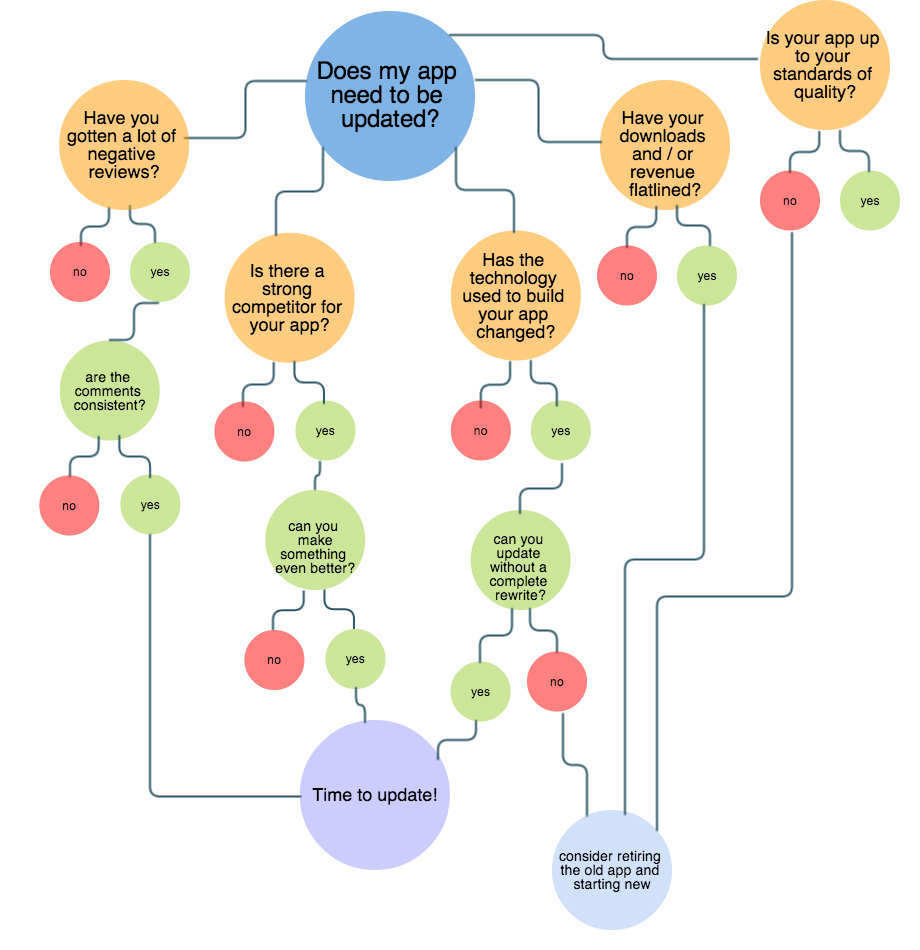Some independent developers and small development shops produce one primary app on which they work progressively to improve, enhance, and optimize.
However the majority of independent developers, especially in the game and educational spheres, have a large app portfolio.
At a certain point, often when a portfolio grows larger than ten apps across app stores, it can become cumbersome and problematic to maintain the quality of a portfolio. Sometimes an app has been rendered obsolete and needs an update. Sometimes it can simply be retired.
Here are some ideas to help you decide when and what to update and a handy flowchart (at the end of article) to help guide maintenance decisions over your apps’ lifespans.
Update or Retire?
To get a better idea why a developer would update or retire an app, I sent a survey to several well-known app developers. All independents, these developers’ portfolios ranged from three to fifty apps or more.
Time for a facelift?
On average, developers update their apps every six months or so, or two to three times during an app’s lifetime.
Many developers use the update process as an opportunity to realign keywords according to the app’s rankings as analyzed in tools such as SensorTower, SearchMan SEO and App Annie. Non-performant ad networks can also be retired and replaced.
Updating includes several standard tasks:
- Updating at least the first screenshot, sometimes all screenshots should be updated for a full UI change
- Updating app keywords and maybe the title and the description
- Sometimes, based on feedback, the app’s icon should be updated
- The video trailer might need to be updated if the UI has entirely changed, this may be the toughest task to complete
The decision to update an app is often externally driven. User feedback often sends a developer back to the codebase to fix bugs. Changes in the law, such as COPPA (Children’s Online Privacy Protection Act) can force changes. COPPA prompted a slew of updates to apps targeting kids, such as adding parental restrictions and changing methods of in-app purchase.
The developer might decide to support a new language for localization purposes to satisfy a market demand. There may be new features requested from customers or new business requirements.
Software and hardware changes can call for maintenance. The move from iOS6 to iOS7 triggered complete revamping of many apps’ UIs.
New hardware capabilities such as motion sensors allow opportunities for enhancements that help boost sales. Decisions to support different device heights and widths call for progressive enhancement of the UI.
External SDK and API changes such as PhoneGap upgrades prompt updates. Third party integrations and their lifecycles should be followed by app developers and kept current.
App updates might call for edits of external products and materials such as web sites, Twitter accounts and Facebook pages that include app information.
All of these considerations can be time-consuming. As Daniel Williams, who maintains a large portfolio, notes:
“Updating apps can be tricky and sometimes it’s worth having a VA or virtual assistant. It saves time to let you focus on more important things.”
When to call it a day
Theo Rushin, who has three apps in stores, noted that his apps are “made with love” and that he has a strong commitment to maintaining them and would not consider retiring them completely.
Sebastian Perez, of Tiny Lemon Games, conversely, said that he would retire an app if the sales were poor or if an older app did not meet his evolving outlook of graphics or UI.
Laura Tallardy took a nuanced market-driven approach, stating that she has retired an app for markets or devices that have become obsolete.
A legitimate reason to retire an app would be if a competitor releases an app with which you believe it is impossible or not cost-effective to compete with. In that situation, you might release a new app that meets a different segment of the market.
All about your brand
In general, the decision to update or retire an app has to do with your brand. You need your app portfolio to be in top form at all times, as it is publicly available for the world to see, download, and rate/review.
It is advisable to create not only a release strategy for your app but also to put it on an update schedule to keep it in fighting form. Regular updates on a well timed schedule will help you maintain a quality portfolio and ensure that your customers know they can expect consistent work from you.

Contributors
With special thanks for their contributions : Laura Tallardy, Dan Williams, Sebastian Perez, Theo Rushin, and Dr. Jakob Bargak. View my own apps portfolio here.
Jen Looper is a Boston-based web and mobile developer, specializing in cross-platform educational and fitness apps for iOS, Android, Nook, Kindle and Windows phone. View her portfolio at www.ladeezfirstmedia.com.





